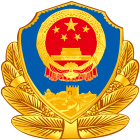China Immigration Inspection
| China Immigration Inspection 中国边检 | |
|---|---|
 Badge of the People's Police (since 1983) (used by CII with the variation: '边警‘ or 'Border Police') | |
 Agency Seal (used in checkpoints) | |
| Agency overview | |
| Formed | November 9, 2018 |
| Legal personality | Law enforcement agency |
| Jurisdictional structure | |
| Operations jurisdiction | People's Republic of China |
| Legal jurisdiction | Mainland China |
| Governing body | State Council, Central People's Government |
| General nature |
|
| Operational structure | |
| Overviewed by | Discipline Inspection and Supervision Team of the National Supervisory Commission of the Central Commission for Discipline Inspection of the Ministry of Public Security |
| Headquarters | Beijing |
| Agency executive |
|
| Parent agency | National Immigration Administration of the Ministry of Public Security |
| Website | |
| National Immigration Administration Shanghai | |
China Immigration Inspection (CII) (Chinese: 中国边检; pinyin: Zhōngguó biān jiǎn) (or: "Entry-Exit Border Inspection Authority of the People's Republic of China") is the government agency responsible for controlling the borders and checkpoints of the People's Republic of China. It is a child agency of the National Immigration Administration (NIA) which in itself is subordinate to the Ministry of Public Security (MPS).[1]
CII is charged with safeguarding national sovereignty, security and social order for transportation and immigration at key ports throughout the country.
History[]
In 1988, the frontier inspection stations of 9 cities: Beijing, Tianjin, Shanghai, Guangzhou, Shenzhen, Zhuhai, Xiamen, Haikou, and Shantou engaged in a reform of the active duty system to change the uniform of border inspection officer to that of the people's police (Chinese: 人民警察; pinyin: Rénmín jǐngchá). Other border checkpoint officers continued to wear the uniforms of the People's Armed Police (PAP). On December 31, 2018, under newly announced reforms, all entry-exit border checkpoints across China were unified under the control of the newly created the NIA.[2]
In 2011, according to the approval of the Central Organization Office, the specifications of 7 professional border inspection stations including the Shenzhen General Border Inspection Station were adjusted from the deputy department level to the main department level, and the institutional affiliation and staffing remained unchanged .
On March 21, 2018, according to the document: "Deepening the Reform of Party and State Institutions" issued by the Central Committee of the Chinese Communist Party stated that public security border troops would no longer be listed as armed police forces, and all existing forces would be retired from active service.[3]
On January 1, 2019, the public security border guards held a collective change-up ceremony to reorganize and professionalise border inspection agencies across the country.[4] The badge on the left side of the uniform was unified as "Immigration Bureau" (in January 2019). A month earlier, the frontier inspection agencies in Beijing, Tianjin, Shanghai, Guangzhou, Shenzhen, Zhuhai, Xiamen, Haikou, and Shantou had their badges on the left side of their uniforms marked with the words "Frontier Inspection"). In this institutional reform, the original provincial-level corps of the public security frontier defense forces were transferred and collectively retired from active service. The provincial (regional) entry-exit border inspection station was adjusted and the border management corps of the public security department of the province (region) was added. Vertical integration by the National Immigration Administration occurred through the revocation of Shantou Entry-Exit Border Inspection General Station, Guangdong Province, Fujian Province, and Hainan Provincial Public Security Frontier Defense Corps.[5] The immigration border inspection stations under this new administration are Guangzhou Entry-Exit Border Inspection General Station, Shenzhen Entry-Exit Border Inspection General Station, and Zhuhai Entry-Exit Border Inspection General Station, Xiamen Entry-Exit Border Inspection General Station and Haikou Entry-Exit Border Inspection General Station. Post reform, the State Immigration Administration led the management of 33 entry-exit border inspection stations.
Organization[]
The day-to-day operations of border inspection agencies are handled by the entry and exit administration bureaus of respective provinces, autonomous regions, and municipalities directly under the auspices of the central government, while the entry and exit border inspection stations of provincial administrative regions are under the direct control of the National Immigration Administration (NIA)(a child agency of the Ministry of Public Security) The administration manages more than 270 air, land and sea border checkpoints across China.
China Immigration Inspection (CII) operates as a child agency of MPS. They are responsible for safeguarding national sovereignty, security, social order, management, and transportation upon entry and exit.[6]
Administrative work related to visa issuance and residency registration are handled by the entry-exit administration bureaus of the public security bureaus of respective provinces, autonomous regions and municipalities directly under the central government. Chinese border authorities also administer entry and exit border inspection posts of Beijing, Tianjin, Shanghai,[7] Guangzhou, Shenzhen, Xiamen, Zhuhai, Shantou and Haikou.
In 2009, China had 277 border control checkpoints, covering entry into China by air, water and land in conjunction with CII (China Immigration Inspection).[8]
References[]
- ^ "Shanghai General Station of Immigration Inspection". www.sh-immigration.gov.cn. Retrieved 2017-02-22.
- ^ admin (2018-06-03). "China establishes new State Immigration Administration". Border Management. Retrieved 2021-08-03.
- ^ "公安边防、消防、警卫部队全部退出现役_新闻_腾讯网". news.qq.com. Archived from the original on March 28, 2018. Retrieved 2021-08-04.
- ^ "新京报 - 好新闻,无止境". www.bjnews.com.cn. Archived from the original on December 25, 2018. Retrieved 2021-08-04.
- ^ "内蒙古自治区政府门户网站 图片新闻 中华人民共和国内蒙古出入境边防检查总站挂牌仪式举行". 2020-11-16. Archived from the original on 2020-11-16. Retrieved 2021-08-04.
- ^ "Shanghai General Station of Immigration Inspection". sh-immigration.gov.cn. Retrieved 2017-04-27.
- ^ "Entry and Exit Inspection". en.shairport.com. Archived from the original on 2017-05-11. Retrieved 2017-04-12.
- ^ Ishida, M. (2013-07-26). Border Economies in the Greater Mekong Sub-region. Springer. ISBN 978-1-137-30291-5.
- Government agencies of China
- Immigration to China
- Immigration services